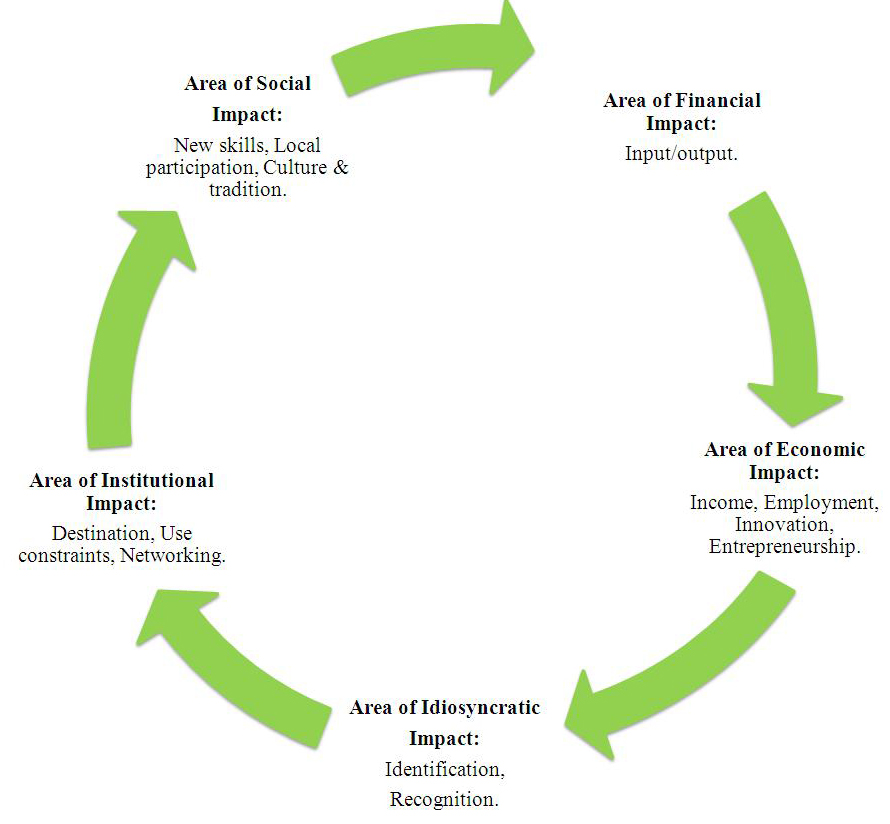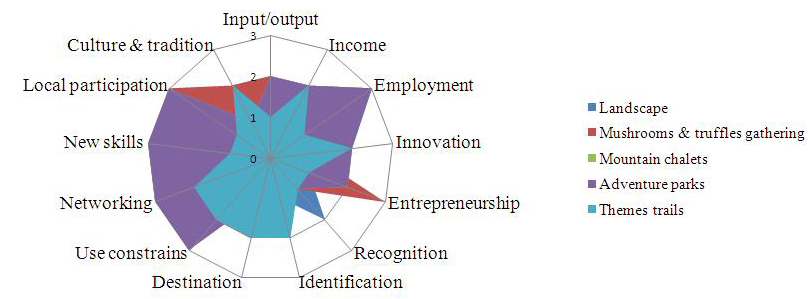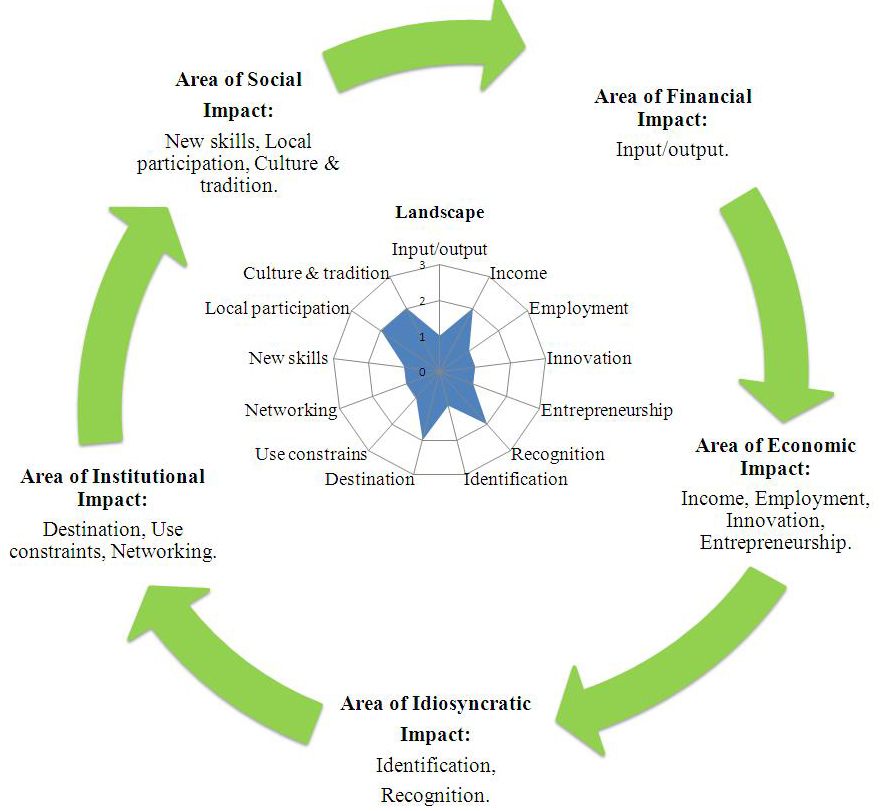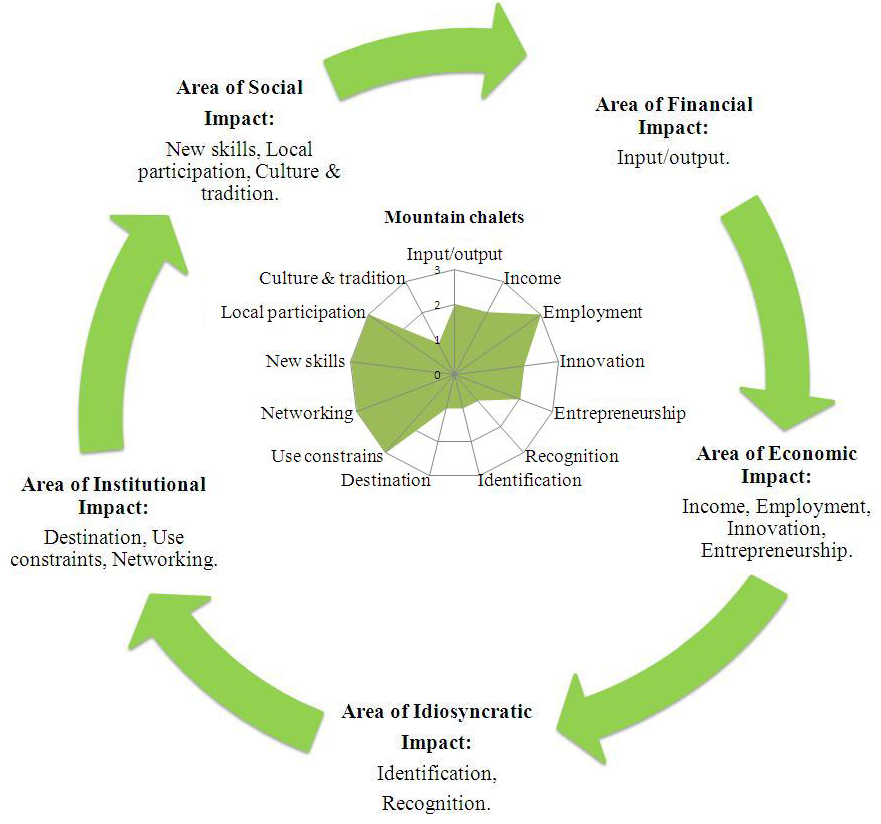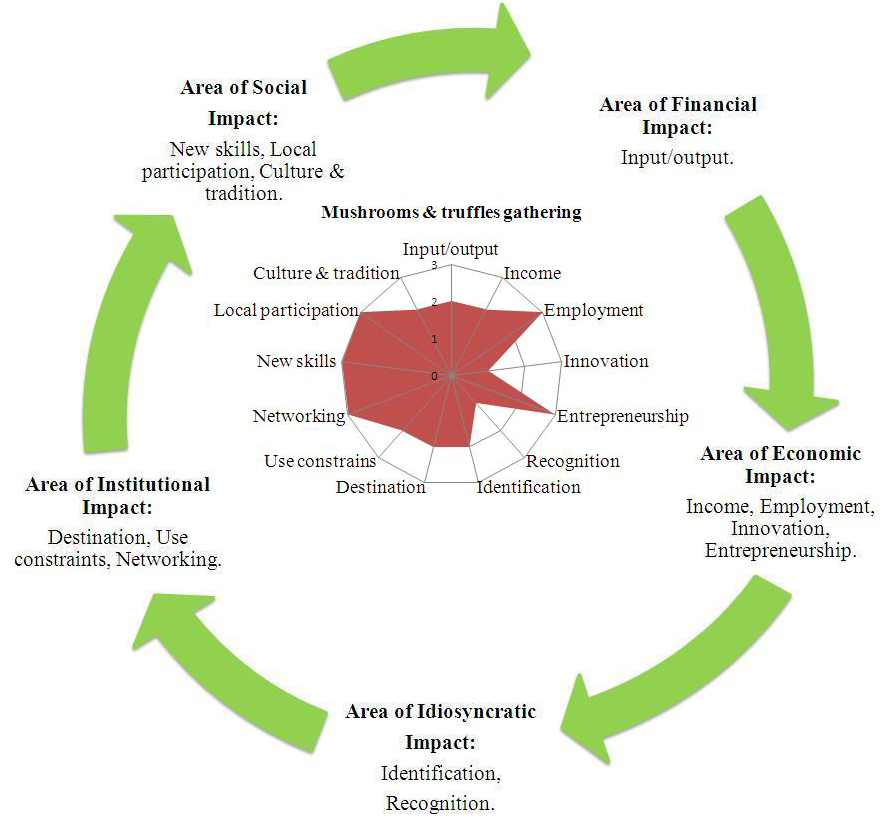
Payment for forest environmental services: a meta-analysis of successful elements
iForest - Biogeosciences and Forestry, Volume 6, Issue 3, Pages 141-149 (2013)
doi: https://doi.org/10.3832/ifor0707-006
Published: Apr 08, 2013 - Copyright © 2013 SISEF
Review Papers
Abstract
Forest ecosystems produce environmental services from which individuals benefit. In recent decades, interest in these services has significantly increased to meet the demand for new products and services related to landscape use and recreational activities. These new products and services are defined as Non-Wood Forest Products and Services (NWFP&Ss). There is the possibility, and in certain cases the need, to introduce a system of payment for these NWFP&Ss. However, the transformation of forest environmental goods and services into commercial products and services is not a straightforward process. This paper reviews a number of successful payment mechanisms for NWFP&Ss in order to examine the elements which contribute to transforming these externalities into sources of income for people living near forests.
Keywords
Payment For Environmental Services (PES), Forest Resources, Non-wood Forest Products And Services, Landscape, Tourism
Introduction
In recent decades, interest in the introduction of payment mechanisms for Non-Wood Forest Products and Services (NWFP&Ss) has grown steadily, due mainly to the need to support sustainable forest development and management. In this context, the concept of the long term sustainability of forests is closely related to the interest of local populations in managing and preserving forests ([1], [23]). Command and control mechanisms are a possible alternative, although they do not guarantee the long term sustainability of forests: the role of local populations appears to be crucial.
Sustainable approaches are intended to diversify and increase the incomes of communities whose economies are based on forest resources. However, the transformation of environmental goods and services associated with forests into commercial products and services is not a straightforward matter, depending, as it does, upon both endogenous and exogenous factors. Various methods have been proposed to overcome the difficulties associated with transforming forest externalities into real sources of income ([20], [35], [28], [36]).
A set of NWFP&Ss may be included within the benefits and recreational activities made available by landscape fruition, that is, by considering a combination of three main values: scenic beauty or landscape value, recreational value, evocative value. Of these, the first two are use values. As regards use value, it is possible to make further distinctions related to the type of use where the landscape is a basic background for activities, or the principal or accessory resource for recreational activities ([9]). Therefore, landscape may be seen as a public good and therefore cost free for users. It is an externality. In this context, the landscape provided by the forest can be subjected to same issues shown before and the externality it produces may represent potential source of income if there are users available to pay to enjoy them.
This paper examines several case studies on the implementation of PES mechanisms, focusing on the factors which facilitate the transformation of these externalities into sources of income for people living near forests.
After a brief examination of the fundamental requirements of payment mechanisms for environmental services (PES), the paper examines the interactions between NWFP&Ss and forest landscapes. Next, five ways in which these interactions can be made explicit will be analyzed: the scenic beauty of the landscape, the recreational use of landscape, adventure parks, mountain chalets, mushrooms and truffles gathering, wood handicraft supply chain and theme trails. Finally, elements that have positively contributed to PES implementation will be examined and highlighted.
Forest products and services
From an anthropocentric perspective, ecosystem services are “benefits people obtain from ecosystems” ([21]). Although general, this definition views forest products and services as ecosystem processes and functions of value to human beings. Thus, the value of ecosystem services may be based in people’s needs rather than having any intrinsic value. However, if an ecosystem is separated from its complex set of functions and features and viewed only from a marketing perspective ([19]), this view may be challenged on the grounds that it underestimates the complexity of ecosystems and suggests inappropriate uses for it, given the highly complex reality of any ecosystem ([25]).
However, other authors welcome the opportunity to consider environmental services in terms of their value for humanity ([5], [37], [18]). While recognizing its limitations, this approach may be useful to sustainable development. Furthermore, attributing an economic value to environmental resources and services implies inducing people to pay for these environmental services and thus to preserve the resource that supplies them ([31], [11]). From the point of view of sustainability, the willingness to pay for such services can be considered a theoretical basis ([35], [12]) for environmental taxes, command and control mechanisms, and integrated conservation and development projects ([34], [12]). Under certain conditions, the willingness to pay can generate financial incentives for local actors to transform the value of natural resources into goods and services ([31], [22]). When the willingness to pay is formalized and results in a PES, environmental services can be introduced to markets in which they are not normally available. However, the value of these services is not well defined because the resources upon which they are based are often considered, at least partially, to be a public good.
Wunder ([35]) suggests four key characteristics of PES mechanisms: voluntary transactions, well-defined environmental services or land use that ensures the availability of those services, the presence of at least one buyer and one provider in the market and a certain degree of reliability in the provision of the service. Most cases do not include all four of these elements and so a mechanism resembling a PES (PES-like) is created, which is not entirely consistent with the theoretical model mentioned above ([36], [32]).
The most frequent deviations from the basic PES model involve the type of incentive proposed, the degree of voluntariness of the transaction, the allocation of property rights and sales, the extent to which the PES is debated locally and the presence of a clear link between the service provided and the actual work setting ([35]).
According to Wunder ([35]), key defining attributes of a PES are that the mechanism be realistic, voluntary and conditional. The ability of a PES to fulfill these conditions varies from situation to situation and its outcome will be influenced by the problems inherent in the situation when the mechanism begins to be implemented.
According to Van Noordwijk & Leimona ([32]) the attributes realistic, voluntary and conditional are attributes of effectiveness (defined in terms of the cause and effect relationship between the explicit acknowledgement of the service provision for which there may be something to pay and the action of payment). These authors identify two other essential attributes: efficiency (as a ratio of the implementation cost of the PES mechanism to the revenue derived from the payment mechanism) and equity (in revenue distribution providing income to local populations).
Landscape use and recreational activities in the forest
In recent decades the forest has come to be recognized as more than just a source of timber; it can also cater to social needs and allow for new forms of resource use ([29]). It is difficult to define the rural landscape as a commodity. One definition views it as a “permanent creative process” ([30]). This entails a twofold investigation of the landscape concept. The first relates to the elements which contribute to physically changing the landscape, the second to an analysis of the dynamic process through time which modifies and develops the landscape, as will be discussed later on ([15]).
The transformation of goods and services associated with the use of the natural landscape and recreational activities into marketable products and services is not straightforward, particularly when dealing with forest resources. As noted by several authors ([20], [35], [28], [36]), different methods and channels exist for the transformation of services, products and externalities of traditional forest management into innovative and profitable products and services.
From a user’s perspective, the value of the natural landscape is the sum of three components: the scenic, recreational and evocative values ([9]). A first distinction for these three components is the use value, derived from the direct use of resources. Considering the three values above, the evocative has no use value, while the scenic and recreational components can be assigned a use value.
The scenic component, which combines several aesthetic qualities, is composed of other values.
The landscape must be regarded as a set of goods rather than as a single product. In particular, within a different framework in which landscape is related to a forest there are at least three possible viewpoints; according to Clawson et al. ([8]) the forest landscape can be understood as follows:
- as completely or partially user-oriented;
- as a “container” for resources facilitating the recreational use of the resources;
- as a background.
The viewpoint chosen will depend on the predominant recreational or scenic value.
Within the framework of landscape use, these different understandings of the landscape will result in different levels of excludability from the mentioned landscape use.
These different degrees of excludability limit the creation of an effective market for the landscape as a commodity. It is not easy to identify a clear link between a product introduced onto the market and the payment requested for that product (the effectiveness attribute), and the identification of producers and beneficiaries is equally complicated. The cultural aspects influencing the interpretation of landscape should not be underestimated ([16]). Thus, it is important that all attempts to apply a PES to a forest landscape should first identify the specific characteristics of that landscape.
In general, the transformation of environmental goods and services into marketable products involves both institutional and ad-hoc interventions at different levels and a commitment to the promotion of those products ([20]). The transformation also implies the redistribution of roles and benefits and the recruitment and training of human capital. Efficiency, effectiveness, an equitable division of costs and benefits and control over the cost of identifying and managing free riders are crucial to the transformation.
So, Wunder’s key attributes ([35]) need to be combined with other requirements, such as efficiency, effectiveness and equity distribution. These attributes come to the fore when attention shifts from the theoretical background to the consequences of PES implementation ([14], [32]).
Description of NWFP&Ss
From the consumer’s perspective, NWFP&Ss can be grouped into three categories: mass, specialized and complementary products and services ([24]).
The analysis of these inputs according to marketing-mix theory (4 Ps) shows that product, price and cost minimization are crucial factors for mass products and services. Promotion is usually supported by brand creation, often linked to the history or territorial uniqueness of the area. The success of this group of NWFP&Ss depends on factors such as the human and social capital involved, weather conditions, the seasonality of products and services, and product perishability.
Non-Wood Forest Products and Services are defined as specialized products and services when certain conditions are met. These specialized products and services have high added value. However, their availability is limited by quantity and environmental or seasonal conditions. Their target market is small. Even when this is the case, within the marketing mix, the product is very important, particularly because of its direct association with quality. However, the risk that products will be imitated is high and so promotional activities remain an important vehicle of differentiation. These activities include the use of environmental and certification labels and alternative merchandising channels, such as web retail (Box 1).
Box 1 - Web references
The following external resources have been cited along the text:
- ⇒ http://goape.co.uk/
- ⇒ http://www.almdof.com/Benvenuti.html
- ⇒ http://www.artesella.it
- ⇒ http://www.associazionecastanicoltori.it/php/index.php?option=com_content&view=article&id=23&Itemid=16
- ⇒ http://www.baiersbronn.de/text/240/en/hiking-huts-und-inns.html
- ⇒ http://www.baumkronenweg.at/bkw/
- ⇒ http://www.hiddenvalleycabins.com.au/bookings.htm
- ⇒ http://www.jungleraiderpark.com/it/home.xhtml
- ⇒ http://www.klanglandschaften.lu/en/trail.htm
- ⇒ http://www.lechalet.biz/
- ⇒ http://www.lesroutesdubois.com/fr/
- ⇒ http://www.megeve-reservation.com/location-megeve
- ⇒ http://www.montagne-alternative.com/
- ⇒ http://www.parcopan.org/it/territorio/ambienti/la-foresta-di-abete-rosso-p92.html
- ⇒ http://www.regione.piemonte.it/montagna/altre/tartufo.htm
- ⇒ http://www.rivistasherwood.it/sherwood.html
- ⇒ http://www.schladming-dachstein.at/en/region/schladming-rohrmoos/summer/sport_aktiv/bogenparcour.html
- ⇒ http://www.schnitza.at/de/index.asp
- ⇒ http://www.sellaneveaparco.it/
- ⇒ http://www.tierpark.at/
- ⇒ http://www.ttadventure.co.uk/
- ⇒ http://www.valleisarco.info
The main feature of complementary products is the combination of relationships and territorial linkages, which provide complementary products and services with features and values that differentiate them from similar products on the market in other areas. Precisely because of these territorial linkages, networking and cooperation between local institutions and the business sector is difficult and creates complex product systems. Products may include more than those obtained from the primary fruition of resources, also covering services like accommodation, food and wine, local customs and traditions. The complementary NWTFP&Ss play a strategic role in the promotion of local rural development strategies that invigorate local businesses and networks ([27]). Two other elements can be added to the traditional 4Ps marketing mix: political power and political participation. Where this addition is possible, the complementary NWFP&Ss manifest unique features associated with participation, political support and strong interaction between public and private stakeholders ([28]).
PES Case studies and the methodological framework
Based on an extensive review of the literature, PESs related to landscape use and recreational activities are grouped thus: landscape (scenic beauty and recreation) - Tab. 1 , adventure parks - Tab. 2, mountain chalets - Tab. 3, wood handicraft supply chains - Tab. 4 and theme trails, mushrooms and truffles gathering - Tab. 5.
Tab. 1 - Landscape.
| Product/ Service |
Location | Marketable Product/ Service |
Who buys | Who sells | Source |
|---|---|---|---|---|---|
| Landscape and scenic beauty | Costa Rica | Landscape management and enhancement of scenic beauty and landscape | Fonafifo (National Autonomous Authority) | Local community and landowners |
[26] |
| Landscape and scenic beauty. Recreational activities | UK | Improvement and enhancement of recreational activities related to natural resources | The UK government and the EU (through European funds and national financial support) | Farmers from selected areas | [10] |
| Recreational activities: safari | Zimbabwe (Campfire) | Biodiversity conservation and enhancement of access to resources | Tourism operators and NGO donors | Local communities through the direction of the local rural council |
[13] |
Tab. 2 - Adventure parks.
| Product/Service | Location | Marketable Product/Service |
Who buys | Who sells | Source |
|---|---|---|---|---|---|
| Go Ape | UK | Adventure parks | Private agents | Private agents/ manager |
⇒ http://goape.co.uk/ |
| Tree Top Adventure | UK (Wales) | Adventure park in Wales | Private agents | Private agents/ manager |
⇒ http://www.ttadventure.co.uk/ |
| Jungle Raider Park | Italy (Como and Lecco provinces) | Two adventure parks | Private agents | Private agents/ manager |
⇒ http://www.jungleraiderpark.com/it/home.xhtml |
| Adventure park Sella Nevea | Italy(Carnia area) | Adventure Park | Private agents | Private agents/ manager |
⇒ http://www.sellaneveaparco.it/ and [33] |
| Bruno’s Bogenparcours | Austria | Archery with 3D targets | Visitors and users | - | ⇒ http://www.schladming-dachstein.at/en/region/schladming-rohrmoos/summer/sport_aktiv/bogenparcour.htm and [33] |
| Wildpark Buchenberg | Austria | Olympic game of forest activities (archery, crossbow, activities related to woodcutting). |
Visitors and users | - | ⇒ http://www.tierpark.at/ and [33] |
Tab. 3 - Mountain Chalets.
| Product/Service | Location | Marketable Product/Service |
Who buys | Who sells | Source |
|---|---|---|---|---|---|
| Almdorf, Seinerzeit | Austria (Carinthia) | Tourist accommodation for tourists and recreation |
Private users/ visitors |
Private managers | ⇒ http://www.almdof.com/Benvenuti.html |
| Montagne- Alternative |
Switzerland | Tourist accommodation for tourists and recreation |
Private users/ visitors |
Private managers | ⇒ http://www.montagne-alternative.com/ |
| La taïga | Switzerland | Tourist accommodation for tourists and recreation |
Private users/ visitors |
Private managers | ⇒ http://www.megeve-reservation.com/location-megeve |
| Le Chalet Tournesol | France | Tourist accommodation for tourists and recreation |
Private users/ visitors |
Private managers | ⇒ http://www.lechalet.biz/ |
| Hidden Valley Cabins | Australia | Tourist accommodation for tourists and recreation |
Private users/ visitors |
Private managers | ⇒ http://www.hiddenvalleycabins.com.au/bookings.htm |
| Destination Baiersbronn | Baiersbronn, Germany | Tourist accommodation and hospitality for tourists and recreation |
Local and foreign visitors | Private managers and various stakeholders | ⇒ http://www.baiersbronn.de/text/240/en/hiking-huts-und-inns.html |
| Baumkronenweg/Baumhotel | Austria | Tourist accommodation and other facilities and activities for tourists and recreation |
Private users/ visitors |
Private managers | ⇒ http://www.baumkronenweg.at/bkw/ and [33] |
| La suite della quercia | Italy | Tourist accommodation for tourists and recreation |
Private users/ visitors |
Private managers | [33] |
Tab. 4 - Wood handicraft supply chain and theme trails.
| Product/ Service |
Location | Marketable Product/Service | Who buys | Who sells | Source |
|---|---|---|---|---|---|
| Resonant spruce wood (a) | Italy, Trentino(Paneveggio province-owned forests) | Resonant spruce wood | Luthiers and private producers of sound boxes for musical instruments |
Manager of the local province-owned forests (APROFOD) | [38] |
| Resonant spruce wood (b) | Italy, Trentino (Collective ownership “Magnifica Comunità di Fiemme”, the violin forest) | Resonant spruce wood | Luthiers and private producers of sound boxes for musical instruments |
Manager of the collectively owned “Magnifica comunità di Fiemme” |
⇒ http://www.parcopan.org/it/territorio/ambienti/la-foresta-di-abete-rosso-p92.html |
| Arte Sella | Italy, Trentino | Open-air museum located in a forest | Visitors and users of the museum |
Museum manager | ⇒ http://www.rivistasherwood.it/sherwood.html; ⇒ http://www.artesella.it |
| Sound trails | Natural Park of Our (Hoscheid, in France, Belgium, and Luxemburg) | Belonging to the Wood routes project |
Visitors and users of the Natural Park of Our |
Natural Park of Our | ⇒ http://www.lesroutesdubois.com/fr/, ⇒ http://www.klanglandschaften.lu/en/trail.htm |
| Holzpark | Austria | Area equipped with woodworking facilities within a forest | - | - | ⇒ http://www.schnitza.at/de/index.asp |
| Chestnut distribution chain |
Alto Adige, Italy | Chestnut trails | Visitors and users | - | ⇒ http://www.valleisarco.info |
| Chestnut sponsorship | Lucca Province, Italy (Garfagna) | Chestnut sponsorship | Private users | Association of chestnut producers |
⇒ http://www.associazionecastanicoltori.it/php/index.php?option=com_content&view=article&id=23&Itemid=16 and [33] |
Tab. 5 - Mushrooms and truffles gathering.
| Product/Service | Location | Marketable Product/Service |
Who buys | Who sells | Source |
|---|---|---|---|---|---|
| Mushrooms gathering | Veneto Region (Italy) | Permits for mushrooms gathering |
Regional and non-regional users |
Municipalities and local bodies | [14] |
| Borgotaro Mushrooms (a) | Parma province |
Forest management to support mushroom productions | Regional and non-regional users |
Local bodies | [14], [7] |
| Borgotaro Mushrooms (b) | Parma province |
Protected geographical indication and Consortium for protection and improvement of Borgotaro mushroom |
Regional and non-regional users |
Local bodies | [14], [7] |
| Truffles | Piedmont | Forest management to support truffles and sustain productions | Regional and non- regional users; and intermediaries |
Activities managed by provincial bodies | ⇒ http://www.regione.piemonte.it/montagna/altre/tartufo.htm |
The literature related to case study analysis of the implementation of PES mechanisms for NWFP&Ss has been examined in detail and a selection of those which the authors believe to be successful is given.
A further analysis of these case studies is then conducted in order to discover the reasons for their success. All these factors have been taken into account and analyzed collectively in order to identify the most powerful and important of them. A 1-2-3 score was then used to compare these elements and provide a graphic representation.
The five groups listed above were created by selecting case studies of successful PES mechanisms. They are grouped according to product type.
Elements driving successful PES mechanism implementation
This analysis of successful case studies allows us to list a number of elements which are either driving or contributing to successful performances of the PES mechanism. The recognition of an environmental resource as a product or service is an important first step in the creation of a PES. When this occurs, the environmental resource is clearly identified as a product or service and it is understood that a price should be paid to access it. This step may not be taken for granted, and although the process is sometimes straightforward, it is often difficult to establish a connection between a product or service and an environmental resource. There are several reasons for these difficulties. One of the most common problems is the identification of the environmental resource as a commercial product or service. Environmental resources are usually considered to be public and are not immediately identified as products or services to be paid for. Therefore, clearly identifying the functions and features of the managing authority and the environmental resource is essential. The environmental resource must be identified and the resource’s availability and affordability as a service or product must be communicated to users.
The next key step must be taken if this environmental product or service is to be recognized as worth paying for and its providers remunerated through a PES mechanism. This emerges clearly as a second success element. To guarantee effective results, the relationship between the product or service and the price must be clear. Accepting the need to pay for a resource implies accepting its value, and the obligation to pay the providers of that resource for its use.
In the studies considered, many goods are recognized as services or products when the creation of added value is clear. Although in the literature, the UK case study for example, the forest landscape is considered an environmental resource that can generate payments, the value of the forest landscape is properly acknowledged when the landscape is linked to other values that complete it and add value. Payment can then usually be demanded for using the environmental resources concerned.
Landscape, along with the culture, tradition and human capital that has changed and modeled it, are the resources upon which a PES mechanism can be constructed.
A third essential element is the identification of the environmental product or service with the entire destination. This identification is more straightforward because the product in question has a widely recognized value. In the cases analyzed, exclusivity and typical local features are the recognized value. In many cases, the success of the products lies precisely in an embedded policy of differentiation in terms of product quality and uniqueness. The product is defined as unique, exclusive and high quality because of a strong territorial connotation. The element of forestry and land management as a whole is fully included as an essential condition for the production of that product or service.
A fourth key to success is the creation of local networks and synergies which lead the entire destination to support a PES. The destination refers to the entire system, combining local stakeholders who interact with the PES at different levels with the additional value of the resource in question. In many cases, the correlation between the product or service and the skills within the area is not immediate and/or regular. Local companies usually only begin to network to create an effective and integrated system after a PES has been implemented and they sometimes require the support of external authorities or public agencies to ensure that this integration occurs (i.e., business consortia and tourist offices).
This public support often takes the form of certifications or similar broadly effective mechanisms (i.e., typical product labels or indications of geographical origin) to ensure a more effective return for the destination image. The network and the creation of synergies mentioned earlier are made even more effective when supported by public bodies. This support is expressed both through active involvement on the part of these institutions and through increased access to funding. In the cases where PESs have been successful it was the institutions and management authorities who dealt with the legal bureaucracy, both formal and informal, involved in implementing a new PES. In addition to the efforts of these stakeholders, local associations and organizations interact at different levels to create a solid foundation for mutual cooperation and consultation.
A very important fifth element is the clear assignment of property rights. Where PESs have been successful, they have involved stakeholders with explicit rights to the property in question. In some cases, the allocation of property rights is complex. When the resource is a natural landscape, the acknowledgment of the services provided by farmers is more important than the formal allocation of property rights. The value of these services is recognized, and the farmers are rewarded for the services they provide to society.
A sixth key element of the successful PESs is the introduction of limits on resource use; these limits have been directly linked to a new perception of a valuable service for the community and service users. One example is charging a fee for a permit to gather mushrooms, another is the creation of paid parking zones to prevent congestion. These limits may be success factors because they are recognized as a guarantee of higher value and higher quality. The introduction of limits and their acceptance strengthens a PES, especially when the mechanism is well designed and the reasons behind the introduction of those limits are clearly explained. The more necessary limits are considered to be, the greater people’s confidence in and support for them is.
There is a seventh element: sometimes the implementation of a PES prompts the introduction of new skills and/or the re-introduction of old skills to the local population and the wider involvement of local expertise, some of which is already being applied in other business sectors. Mountain chalets and adventure parks require new skills. In other case studies, skills and activities already available in the area (such as the production of local crafts, food, wine and accommodation) have been regained, and are being used to create products and services integrated into the overall exploitation of local resources.
This integration of different skills and local business activities reveals how important local culture and the optimization of tradition are to the successful implementation of a PES, in addition to the strong involvement of local residents.
Other economic and financial related factors were identified as success factors. One of these is the relation between input and output. This relation is the ratio of the resources used to the economic, financial, social and idiosyncratic (identification and recognition successful elements) results. It is represented by a comparison between the amount of resources used and the effects produced by them in terms of socio-economic and financial results. This factor is particularly evident in adventure parks and mountain chalets, where private investment is most common.
In all of the case studies analyzed the creation of additional income and new jobs is important; the PESs analyzed have been implemented in rural areas, where the economy is usually underdeveloped.
Finally, two other elements to be taken into account are the introduction of innovative factors and the strong entrepreneurial drivers that developed subsequent to the introduction of PESs.
In the 28 cases studied, the identified keys to success have been grouped into five areas of impact: economic, financial, social, institutional and idiosyncratic.
All the listed elements contribute to the successful implementation of a PES mechanism: “New skills, Local participation, Culture and tradition, Input/output ratio, Income, Employment, Innovation, Entrepreneurship, Identification, Recognition, Destination, Networking, Use constraints”. They have been aggregated in areas of impact according to authors analysis of the case studies. In most of the case studies there was evidence of a relationships between certain elements. Although, they can emerge as single contribution to the determine the success of the PES mechanism implementation, this relationship is reflected by the elements belonging to the same area of impact. The relationships between the areas are defined in Fig. 1.
Fig. 1 - Relationship between areas of impact according to which the successful elements derived from the case study analysis can be grouped.
These key elements appear crucial for the long term success of a PES. The input-output ratio falls within the financial area of impact, while income, employment, innovation and entrepreneurship belong in the economic area of impact. The generation of new skills, local participation and the enhancement of local culture and traditions are social components. Destination, use constraints and networking belong in the institutional area of impact, while the idiosyncratic area includes landscape identification and recognition.
Fig. 2 and Fig. 3 to Fig. 7 show, first in an aggregate frame and then individually, the analyzed success factors, which have been scored from 1 to 3 on the basis of their degree of presence and development in the case studies. The scores range from 1 to 3, where 1 implies a minimum degree of presence, 2 a medium degree, and 3 a maximum presence; they indicate the degree of development and importance of the factor to the final PES implementation. Scores are assigned as a value of the factors developed within each case study in comparison with the others.
Fig. 3 - Success elements emerging from the case studies analyzed, distributed by impact areas: Landscape.
Fig. 7 - Success elements emerging from the case studies analyzed, distributed by impact areas: Adventure parks.
The radar charts give an overview of the results (Fig. 2) and of the differences between the five subsets concerned (Fig. 3, Fig. 4, Fig. 5, Fig. 6, Fig. 7). They show the importance of the financial factor in mushroom and truffle collecting, mountain chalets and adventure parks. Radar charts are widely used to explain the dynamics between interconnected variables or factors ([3], [6], [4], [17]) and are also used in qualitative analysis ([2]), mainly to rank the attributes of the variables involved. The charts allow for ease and clarity of interpretation. Here we use a qualitative score to classify the success factors .
Fig. 4 - Success elements emerging from the case studies analyzed, distributed by impact areas: Mountain chalets.
Fig. 5 - Success elements emerging from the case studies analyzed, distributed by impact areas: Theme trails.
Fig. 6 - Success elements emerging from the case studies analyzed, distributed by impact areas: Mushrooms & truffles gathering.
Theme trails scored highest for innovation and entrepreneurship factors.
The recognition of environmental resources as potential products and services is scored from 1 to 2. This is best achieved in the landscape and theme trail cases, where forest resources have been integrated within a market system more effectively and profitably than in other cases.
Within the institutional area of impact, destination is the most frequently highlighted factor in the landscape and theme trail cases. The use of limits and constraint is much more evident in the mountain chalet and adventure park cases. In almost all the case studies, skills and local participation are extremely important, as is fostering local culture and tradition.
Conclusions
Our analysis of the case studies reveals that the creation of a successful PES depends on its ability to enhance a variety of different features. Building a system that takes specific local circumstances into account is crucial, as is the possibility to introduce effective and appropriate management models. It is also important to involve local - public and private - stakeholders and to gain their support for the PES.
The fact that the PES model has not been widely adopted can be explained by a number of factors, including the objective difficulties involved in its implementation and the paucity of standard models, which means that each scheme must identify its own specific solutions. Each PES must be appropriate and relevant to its context. The dissemination and implementation of PESs will require testing and repetition and there is an inevitable risk of (varying degrees of) failure.
Each PES also needs to be adapted in accordance with the product(s) and service(s) it is marketing.
References
Gscholar
Gscholar
Gscholar
Gscholar
Gscholar
Gscholar
Gscholar
Gscholar
Online | Gscholar
Gscholar
Gscholar
Gscholar
Gscholar
Gscholar
Gscholar
Gscholar
Gscholar
Authors’ Info
Corresponding author
Paper Info
Citation
Gios G, Rizio D (2013). Payment for forest environmental services: a meta-analysis of successful elements. iForest 6: 141-149. - doi: 10.3832/ifor0707-006
Academic Editor
Marco Borghetti
Paper history
Received: Jul 27, 2012
Accepted: Jan 09, 2013
First online: Apr 08, 2013
Publication Date: Jun 01, 2013
Publication Time: 2.97 months
Copyright Information
© SISEF - The Italian Society of Silviculture and Forest Ecology 2013
Open Access
This article is distributed under the terms of the Creative Commons Attribution-Non Commercial 4.0 International (https://creativecommons.org/licenses/by-nc/4.0/), which permits unrestricted use, distribution, and reproduction in any medium, provided you give appropriate credit to the original author(s) and the source, provide a link to the Creative Commons license, and indicate if changes were made.
Web Metrics
Breakdown by View Type
Article Usage
Total Article Views: 63369
(from publication date up to now)
Breakdown by View Type
HTML Page Views: 53268
Abstract Page Views: 3382
PDF Downloads: 4900
Citation/Reference Downloads: 80
XML Downloads: 1739
Web Metrics
Days since publication: 4658
Overall contacts: 63369
Avg. contacts per week: 95.23
Article Citations
Article citations are based on data periodically collected from the Clarivate Web of Science web site
(last update: Mar 2025)
Total number of cites (since 2013): 8
Average cites per year: 0.62
Publication Metrics
by Dimensions ©
Articles citing this article
List of the papers citing this article based on CrossRef Cited-by.
Related Contents
iForest Similar Articles
Review Papers
Paying for water-related forest services: a survey on Italian payment mechanisms
vol. 5, pp. 210-215 (online: 12 August 2012)
Research Articles
Payments for forest environmental services: organisational models and related experiences in Italy
vol. 2, pp. 133-139 (online: 30 July 2009)
Research Articles
Forest and tourism: economic evaluation and management features under sustainable multifunctionality
vol. 2, pp. 192-197 (online: 15 October 2009)
Research Articles
A Decision Support System for trade-off analysis and dynamic evaluation of forest ecosystem services
vol. 11, pp. 171-180 (online: 19 February 2018)
Editorials
Adaptation of forest landscape to environmental changes
vol. 2, pp. 127 (online: 30 July 2009)
Research Articles
Green oriented urban development for urban ecosystem services provision in a medium sized city in southern Italy
vol. 7, pp. 385-395 (online: 19 May 2014)
Technical Reports
Tourism innovation in the forestry sector: comparative analysis between Auckland Region (New Zealand) and Trentino (Italy)
vol. 5, pp. 262-271 (online: 24 October 2012)
Research Articles
Communicating spatial planning decisions at the landscape and farm level with landscape visualization
vol. 7, pp. 434-442 (online: 19 May 2014)
Research Articles
Vascular plants diversity in short rotation coppices: a reliable source of ecosystem services or farmland dead loss?
vol. 13, pp. 345-350 (online: 17 August 2020)
Research Articles
Evaluation of urban forest landscape health: a case study of the Nanguo Peach Garden, China
vol. 13, pp. 175-184 (online: 02 May 2020)
iForest Database Search
Search By Author
Search By Keyword
Google Scholar Search
Citing Articles
Search By Author
Search By Keywords
PubMed Search
Search By Author
Search By Keyword

